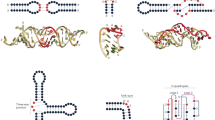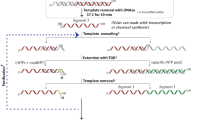Abstract
Nucleotide analog interference mapping (NAIM) is a powerful chemogenetic approach that allows RNA structure and function to be characterized at the atomic level. Random modifications of base or backbone moieties are incorporated into the RNA transcript as nucleotide analog phosphorothioates. The resulting RNA pool is then subjected to a stringent selection step, in which the RNA has to accomplish a specific task, for example, folding. RNA functional groups important for this process can be identified by physical isolation of the functional and the nonfunctional RNA molecules and subsequent mapping of the modified nucleotide positions in both RNA populations by iodine cleavage of the susceptible phosphorothioate linkage. This approach has been used to analyze a variety of aspects of RNA biochemistry, including RNA structure, catalysis and ligand interaction. Here, I describe how to set up a NAIM assay for studying RNA folding. This protocol can be readily adapted to study any RNAs and their properties. The time required to complete the experiment is dependent on the length of the RNA and the number of atomic modifications tested. In general, a single NAIM experiment can be completed in 1–2 weeks, but expect a time frame of several weeks to obtain reliable and statistically meaningful results.
This is a preview of subscription content, access via your institution
Access options
Subscribe to this journal
Receive 12 print issues and online access
$259.00 per year
only $21.58 per issue
Buy this article
- Purchase on Springer Link
- Instant access to full article PDF
Prices may be subject to local taxes which are calculated during checkout



Similar content being viewed by others
References
Brunel, C. & Romby, P. Probing RNA structure and RNA-ligand complexes with chemical probes. Methods Enzymol. 318, 3–21 (2000).
Shcherbakova, I., Mitra, S., Beer, R.H. & Brenowitz, M. Fast Fenton footprinting: a laboratory-based method for the time-resolved analysis of DNA, RNA and proteins. Nucleic Acids Res. 34, e48 (2006).
Hampel, K.J. & Burke, J.M. Time-resolved hydroxyl-radical footprinting of RNA using Fe(II)-EDTA. Methods 23, 233–239 (2001).
Urlaub, H., Hartmuth, K. & Luhrmann, R. A two-tracked approach to analyze RNA-protein crosslinking sites in native, nonlabeled small nuclear ribonucleoprotein particles. Methods 26, 170–181 (2002).
Reed, R. & Chiara, M.D. Identification of RNA-protein contacts within functional ribonucleoprotein complexes by RNA site-specific labeling and UV crosslinking. Methods 18, 3–12 (1999).
Noah, J.W. & Lambowitz, A.M. Effects of maturase binding and Mg2+ concentration on group II intron RNA folding investigated by UV cross-linking. Biochemistry 42, 12466–12480 (2003).
Sigel, R.K. & Pyle, A.M. Lanthanide ions as probes for metal ions in the structure and catalytic mechanism of ribozymes. Met. Ions Biol. Syst. 40, 477–512 (2003).
Streicher, B., Westhof, E. & Schroeder, R. The environment of two metals ions surrounding the splice site of a group I intron. EMBO J. 15, 2556–2564 (1996).
Polacek, N. & Barta, A. Metal ion probing of rRNAs: evidence for evolutionarily conserved divalent cation binding pockets. RNA 4, 1282–1294 (1998).
Fedorova, O., Boudvillain, M., Kawaoka, J. & Pyle, A.M. Nucleotide analog interference mapping and suppression: specific applications in studies of RNA tertiary structure, dynamic helicase mechanism and RNA–protein interactions. in Handbook of RNA Biochemistry (eds. Hartmann, R.K., Bindereif, A., Schön, A. & Westhof, E.) pp. 259–293 (Wiley-VCH, Weinheim, 2005).
Ryder, S.P., Ortoleva-Donnelly, L., Kosek, A.B. & Strobel, S.A. Chemical probing of RNA by nucleotide analog interference mapping. Methods Enzymol. 317, 92–109 (2000).
Vortler, L.C. & Eckstein, F. Phosphorothioate modification of RNA for stereochemical and interference analyses. Methods Enzymol. 317, 74–91 (2000).
Christian, E.L. & Yarus, M. Metal coordination sites that contribute to structure and catalysis in the group I intron from Tetrahymena. Biochemistry 32, 4475–4480 (1993).
Kazantsev, A.V. & Pace, N.R. Identification by modification-interference of purine N-7 and ribose 2′- OH groups critical for catalysis by bacterial ribonuclease P. RNA 4, 937–947 (1998).
Rox, C., Feltens, R., Pfeiffer, T. & Hartmann, R.K. Potential contact sites between the protein and RNA subunit in the Bacillus subtilis RNase P holoenzyme. J. Mol. Biol. 315, 551–560 (2002).
Siew, D., Zahler, N.H., Cassano, A.G., Strobel, S.A. & Harris, M.E. Identification of adenosine functional groups involved in substrate binding by the ribonuclease P ribozyme. Biochemistry 38, 1873–1883 (1999).
Ortoleva-Donnelly, L., Szewczak, A.A., Gutell, R.R. & Strobel, S.A. The chemical basis of adenosine conservation throughout the Tetrahymena ribozyme. RNA 4, 498–519 (1998).
Strauss-Soukup, J.K. & Strobel, S.A. A chemical phylogeny of group I introns based upon interference mapping of a bacterial ribozyme. J. Mol. Biol. 302, 339–358 (2000).
Strobel, S.A. & Shetty, K. Defining the chemical groups essential for Tetrahymena group I intron function by nucleotide analog interference mapping. Proc. Natl. Acad. Sci. USA 94, 2903–2908 (1997).
Boudvillain, M. & Pyle, A.M. Defining functional groups, core structural features and inter-domain tertiary contacts essential for group II intron self-splicing: a NAIM analysis. EMBO J. 17, 7091–7104 (1998).
Fedorova, O. & Pyle, A.M. Linking the group II intron catalytic domains: tertiary contacts and structural features of domain 3. EMBO J. 24, 3906–3916 (2005).
Waldsich, C. & Pyle, A.M. A folding control element for tertiary collapse of a group II intron ribozyme. Nat. Struct. Mol. Biol. 14, 37–44 (2007).
Waldsich, C. & Pyle, A.M. A kinetic intermediate that regulates proper folding of a group II intron RNA. J. Mol. Biol. 375, 572–580 (2008).
Oyelere, A.K., Kardon, J.R. & Strobel, S.A. pK(a) perturbation in genomic Hepatitis Delta Virus ribozyme catalysis evidenced by nucleotide analogue interference mapping. Biochemistry 41, 3667–3675 (2002).
Tuschl, T., Ng, M.M., Pieken, W., Benseler, F. & Eckstein, F. Importance of exocyclic base functional groups of central core guanosines for hammerhead ribozyme activity (published erratum appears in Biochemistry 33, 848 (1994)). Biochemistry 32, 11658–11668 (1993).
Williams, D.M., Pieken, W.A. & Eckstein, F. Function of specific 2′-hydroxyl groups of guanosines in a hammerhead ribozyme probed by 2′ modifications. Proc. Natl. Acad. Sci. USA 89, 918–921 (1992).
Chowrira, B.M. & Burke, J.M. Extensive phosphorothioate substitution yields highly active and nuclease-resistant hairpin ribozymes. Nucleic Acids Res. 20, 2835–2840 (1992).
Ryder, S.P. et al. Investigation of adenosine base ionization in the hairpin ribozyme by nucleotide analog interference mapping. RNA 7, 1454–1463 (2001).
Ryder, S.P. & Strobel, S.A. Nucleotide analog interference mapping of the hairpin ribozyme: implications for secondary and tertiary structure formation. J. Mol. Biol. 291, 295–311 (1999).
Jones, F.D. & Strobel, S.A. Ionization of a critical adenosine residue in the Neurospora Varkud Satellite ribozyme active site. Biochemistry 42, 4265–4276 (2003).
Ruffner, D.E. & Uhlenbeck, O.C. Thiophosphate interference experiments locate phosphates important for the hammerhead RNA self-cleavage reaction. Nucleic Acids Res. 18, 6025–6029 (1990).
Vortler, C.S., Fedorova, O., Persson, T., Kutzke, U. & Eckstein, F. Determination of 2′-hydroxyl and phosphate groups important for aminoacylation of Escherichia coli tRNAAsp: a nucleotide analogue interference study. RNA 4, 1444–1454 (1998).
Jansen, J.A., McCarthy, T.J., Soukup, G.A. & Soukup, J.K. Backbone and nucleobase contacts to glucosamine-6-phosphate in the glmS ribozyme. Nat. Struct. Mol. Biol. 13, 517–523 (2006).
Cochrane, J.C., Batey, R.T. & Strobel, S.A. Quantitation of free energy profiles in RNA-ligand interactions by nucleotide analog interference mapping. RNA 9, 1282–1289 (2003).
Basu, S. et al. A specific monovalent metal ion integral to the AA platform of the RNA tetraloop receptor. Nat. Struct. Biol. 5, 986–992 (1998).
Luptak, A. & Doudna, J.A. Distinct sites of phosphorothioate substitution interfere with folding and splicing of the Anabaena group I intron. Nucleic Acids Res. 32, 2272–2280 (2004).
Eckstein, F. Nucleoside phosphorothioates. Annu. Rev. Biochem. 54, 367–402 (1985).
Eckstein, F. & Gish, G. Phosphorothioates in molecular biology. Trends Biochem. Sci. 14, 97–100 (1989).
Gish, G. & Eckstein, F. DNA and RNA sequence determination based on phosphorothioate chemistry. Science 240, 1520–1522 (1988).
Ryder, S.P. & Strobel, S.A. Nucleotide analog interference mapping. Methods 18, 38–50 (1999).
Strobel, S.A. A chemogenetic approach to RNA function/structure analysis. Curr. Opin. Struct. Biol. 9, 346–352 (1999).
Cochrane, J.C. & Strobel, S.A. Probing RNA structure and function by nucleotide analog interference mapping. in Current Protocols in Nucleic Acid Chemistry (eds. Beaucage, S.L., Bergstrom, D.E., Glick, G.D. & Jones, R.A.) 6.9.1–6.9.21 (John Wiley & Sons, Hoboken, New Jersey, 2004).
Ryder, S.P. & Strobel, S.A. Comparative analysis of hairpin ribozyme structures and interference data. Nucleic Acids Res. 30, 1287–1291 (2002).
Basu, S. & Strobel, S.A. Biochemical detection of monovalent metal ion binding sites within RNA. Methods 23, 264–275 (2001).
Soukup, J.K., Minakawa, N., Matsuda, A. & Strobel, S.A. Identification of A-minor tertiary interactions within a bacterial group I intron active site by 3-deazaadenosine interference mapping. Biochemistry 41, 10426–10438 (2002).
Boudvillain, M., Delencastre, A. & Pyle, A.M. A new RNA tertiary interaction that links active-site domains of a group II intron and anchors them at the site of catalysis. Nature 406, 315–318 (2000).
Szewczak, A.A., Ortoleva-Donnelly, L., Ryder, S.P., Moncoeur, E. & Strobel, S.A. A minor groove RNA triple helix within the catalytic core of a group I intron. Nat. Struct. Biol. 5, 1037–1042 (1998).
Arabshahi, A. & Frey, P.A. A simplified procedure for synthesizing nucleoside 1-thiotriphosphates: dATP alpha S, dGTP alpha S, UTP alpha S, and dTTP alpha S. Biochem. Biophys. Res. Commun. 204, 150–155 (1994).
Oyelere, A.K. & Strobel, S.A. Biochemical detection of cytidine protonation within RNA. J. Am. Chem. Soc. 122, 10259–10267 (2000).
Ortoleva-Donnelly, L., Kronman, M. & Strobel, S.A. Identifying RNA minor groove tertiary contacts by nucleotide analogue interference mapping with N2-methylguanosine. Biochemistry 37, 12933–12942 (1998).
Doherty, E.A., Batey, R.T., Masquida, B. & Doudna, J.A. A universal mode of helix packing in RNA. Nat. Struct. Biol. 8, 339–343 (2001).
Pyle, A.M., Fedorova, O. & Waldsich, C. Folding of group II introns: a model system for large, multidomain RNAs? Trends Biochem. Sci. 32, 138–145 (2007).
Su, L.J., Waldsich, C. & Pyle, A.M. An obligate intermediate along the slow folding pathway of a group II intron ribozyme. Nucleic Acids Res. 33, 6674–6687 (2005).
Gutell, R.R., Cannone, J.J., Shang, Z., Du, Y. & Serra, M.J. A story: unpaired adenosine bases in ribosomal RNAs. J. Mol. Biol. 304, 335–354 (2000).
Basu, S., Pazsint, C. & Chowdhury, G. Analysis of ribozyme structure and function by nucleotide analog interference mapping. Methods Mol. Biol. 252, 57–75 (2004).
Sousa, R. & Padilla, R. A mutant T7 RNA polymerase as a DNA polymerase. EMBO J. 14, 4609–4621 (1995).
Swisher, J., Su, L., Brenowitz, M., Anderson, V. & Pyle, A. Productive folding to the native state by a group II intron ribozyme. J. Mol. Biol. 315, 297–310 (2002).
Huang, Z. & Szostak, J.W. A simple method for 3′-labeling of RNA. Nucleic Acids Res. 24, 4360–4361 (1996).
Das, R., Laederach, A., Pearlman, S.M., Herschlag, D. & Altman, R.B. SAFA: semi-automated footprinting analysis software for high-throughput quantification of nucleic acid footprinting experiments. RNA 11, 344–354 (2005).
Shcherbakova, I. & Brenowitz, M. Perturbation of the hierarchical folding of a large RNA by the destabilization of its Scaffold's tertiary structure. J. Mol. Biol. 354, 483–496 (2005).
Christian, E.L. & Yarus, M. Analysis of the role of phosphate oxygens in the group I intron from Tetrahymena. J. Mol. Biol. 228, 743–758 (1992).
Acknowledgements
Anna Marie Pyle is acknowledged for her support and helpful suggestions. I thank Olga Fedorova for many invaluable discussions and for critically reading the manuscript. Funding was in part provided by National Institutes of Health (NIH) grant GM50313 to A.M. Pyle when I was a postdoctoral associate in her lab and by the Austrian Science Foundation (FWF; J2332) to C.W.
Author information
Authors and Affiliations
Corresponding author
Supplementary information
Supplementary Table 1
Sample NAIM data (XLS 28 kb)
Rights and permissions
About this article
Cite this article
Waldsich, C. Dissecting RNA folding by nucleotide analog interference mapping (NAIM). Nat Protoc 3, 811–823 (2008). https://doi.org/10.1038/nprot.2008.45
Published:
Issue Date:
DOI: https://doi.org/10.1038/nprot.2008.45
Comments
By submitting a comment you agree to abide by our Terms and Community Guidelines. If you find something abusive or that does not comply with our terms or guidelines please flag it as inappropriate.



